key PONTIAC GRAND PRIX 2004 User Guide
[x] Cancel search | Manufacturer: PONTIAC, Model Year: 2004, Model line: GRAND PRIX, Model: PONTIAC GRAND PRIX 2004Pages: 432, PDF Size: 2.99 MB
Page 72 of 432
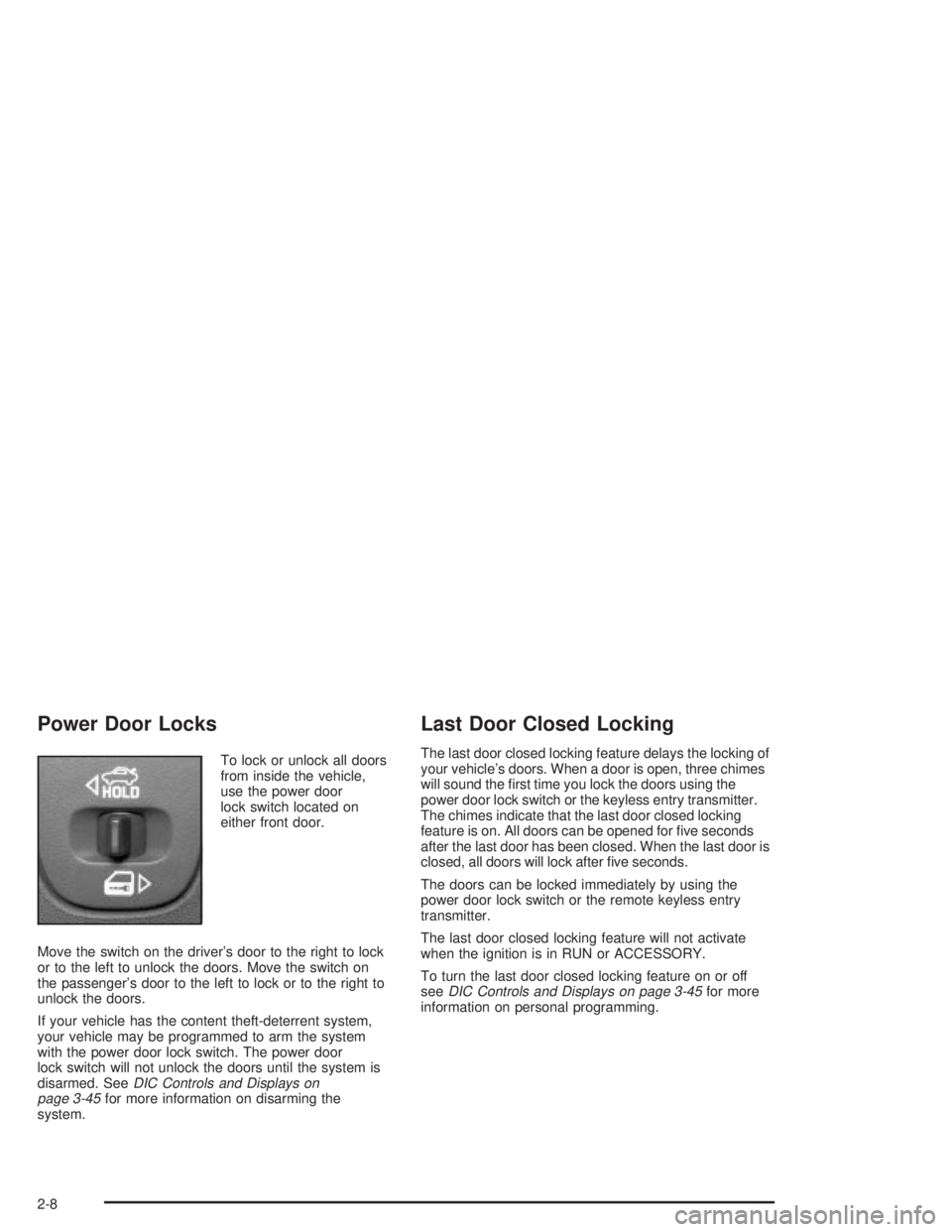
Power Door Locks
To lock or unlock all doors
from inside the vehicle,
use the power door
lock switch located on
either front door.
Move the switch on the driver's door to the right to lock
or to the left to unlock the doors. Move the switch on
the passenger's door to the left to lock or to the right to
unlock the doors.
If your vehicle has the content theft-deterrent system,
your vehicle may be programmed to arm the system
with the power door lock switch. The power door
lock switch will not unlock the doors until the system is
disarmed. See
DIC Controls and Displays on
page 3-45for more information on disarming the
system.
Last Door Closed Locking
The last door closed locking feature delays the locking of
your vehicle's doors. When a door is open, three chimes
will sound the ®rst time you lock the doors using the
power door lock switch or the keyless entry transmitter.
The chimes indicate that the last door closed locking
feature is on. All doors can be opened for ®ve seconds
after the last door has been closed. When the last door is
closed, all doors will lock after ®ve seconds.
The doors can be locked immediately by using the
power door lock switch or the remote keyless entry
transmitter.
The last door closed locking feature will not activate
when the ignition is in RUN or ACCESSORY.
To turn the last door closed locking feature on or off
see
DIC Controls and Displays on page 3-45for more
information on personal programming.
2-8
Page 73 of 432
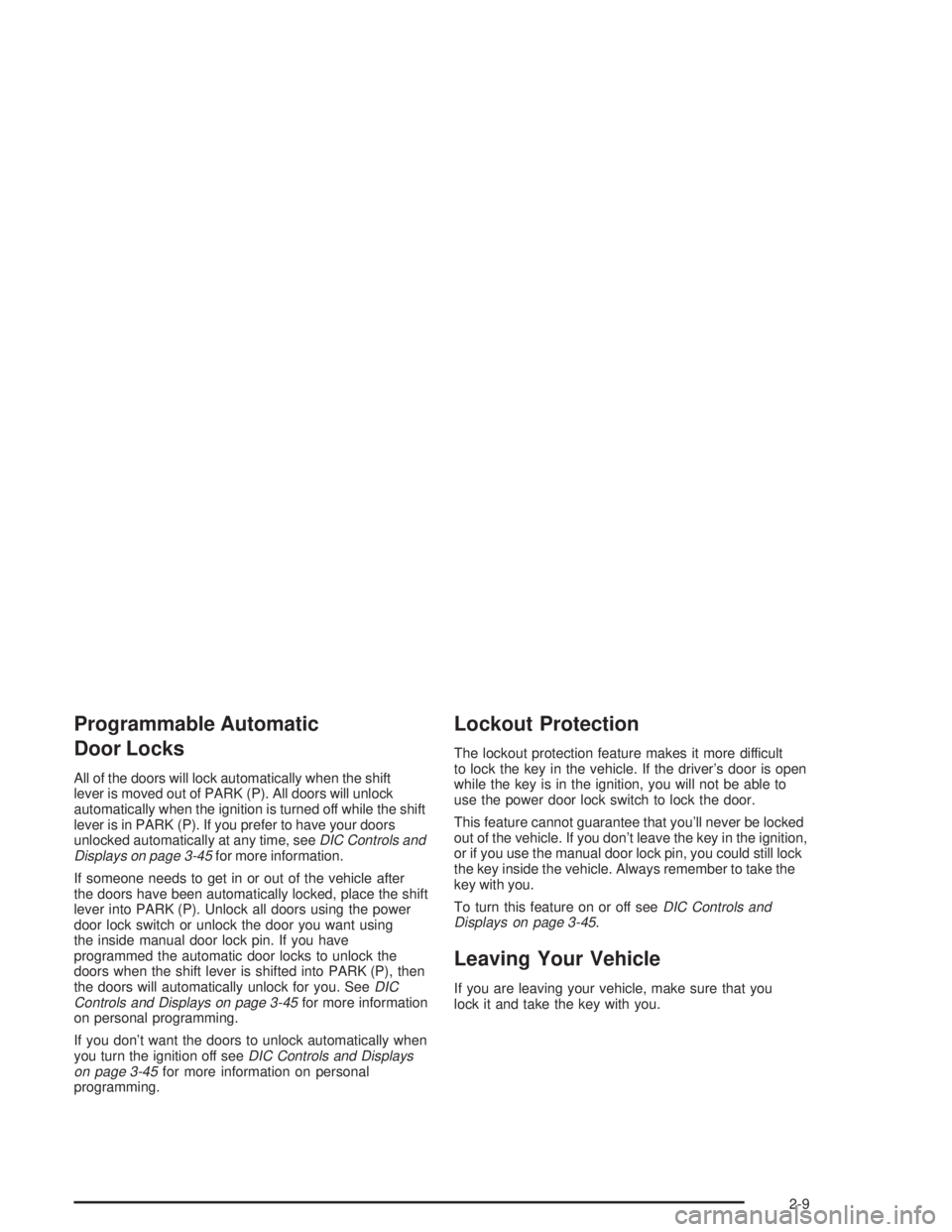
Programmable Automatic
Door Locks
All of the doors will lock automatically when the shift
lever is moved out of PARK (P). All doors will unlock
automatically when the ignition is turned off while the shift
lever is in PARK (P). If you prefer to have your doors
unlocked automatically at any time, see
DIC Controls and
Displays on page 3-45for more information.
If someone needs to get in or out of the vehicle after
the doors have been automatically locked, place the shift
lever into PARK (P). Unlock all doors using the power
door lock switch or unlock the door you want using
the inside manual door lock pin. If you have
programmed the automatic door locks to unlock the
doors when the shift lever is shifted into PARK (P), then
the doors will automatically unlock for you. See
DIC
Controls and Displays on page 3-45for more information
on personal programming.
If you don't want the doors to unlock automatically when
you turn the ignition off see
DIC Controls and Displays
on page 3-45for more information on personal
programming.
Lockout Protection
The lockout protection feature makes it more difficult
to lock the key in the vehicle. If the driver's door is open
while the key is in the ignition, you will not be able to
use the power door lock switch to lock the door.
This feature cannot guarantee that you'll never be locked
out of the vehicle. If you don't leave the key in the ignition,
or if you use the manual door lock pin, you could still lock
the key inside the vehicle. Always remember to take the
key with you.
To turn this feature on or off see
DIC Controls and
Displays on page 3-45.
Leaving Your Vehicle
If you are leaving your vehicle, make sure that you
lock it and take the key with you.
2-9
Page 74 of 432
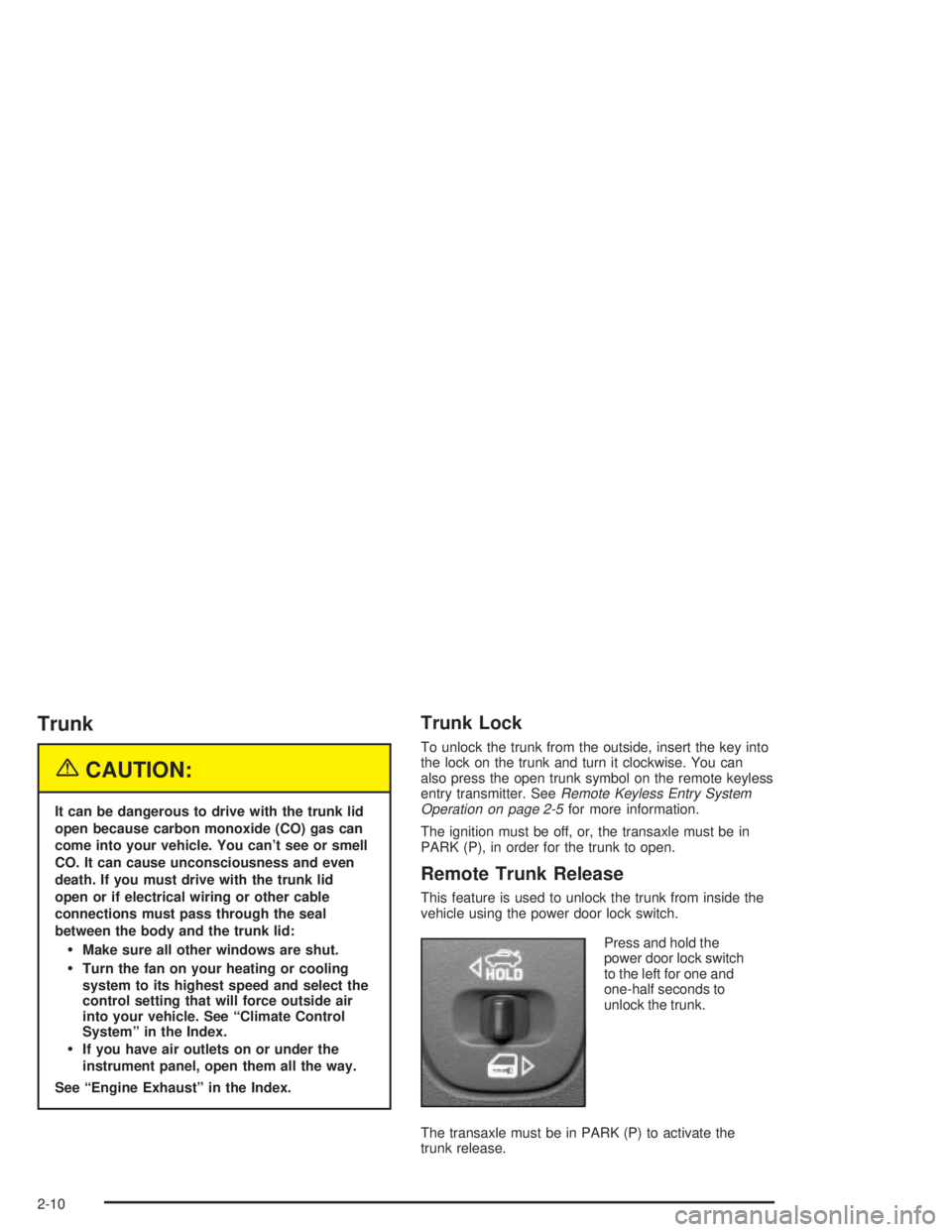
Trunk
{CAUTION:
It can be dangerous to drive with the trunk lid
open because carbon monoxide (CO) gas can
come into your vehicle. You can't see or smell
CO. It can cause unconsciousness and even
death. If you must drive with the trunk lid
open or if electrical wiring or other cable
connections must pass through the seal
between the body and the trunk lid:
·Make sure all other windows are shut.
·Turn the fan on your heating or cooling
system to its highest speed and select the
control setting that will force outside air
into your vehicle. See ªClimate Control
Systemº in the Index.
·If you have air outlets on or under the
instrument panel, open them all the way.
See ªEngine Exhaustº in the Index.
Trunk Lock
To unlock the trunk from the outside, insert the key into
the lock on the trunk and turn it clockwise. You can
also press the open trunk symbol on the remote keyless
entry transmitter. See
Remote Keyless Entry System
Operation on page 2-5for more information.
The ignition must be off, or, the transaxle must be in
PARK (P), in order for the trunk to open.
Remote Trunk Release
This feature is used to unlock the trunk from inside the
vehicle using the power door lock switch.
Press and hold the
power door lock switch
to the left for one and
one-half seconds to
unlock the trunk.
The transaxle must be in PARK (P) to activate the
trunk release.
2-10
Page 78 of 432
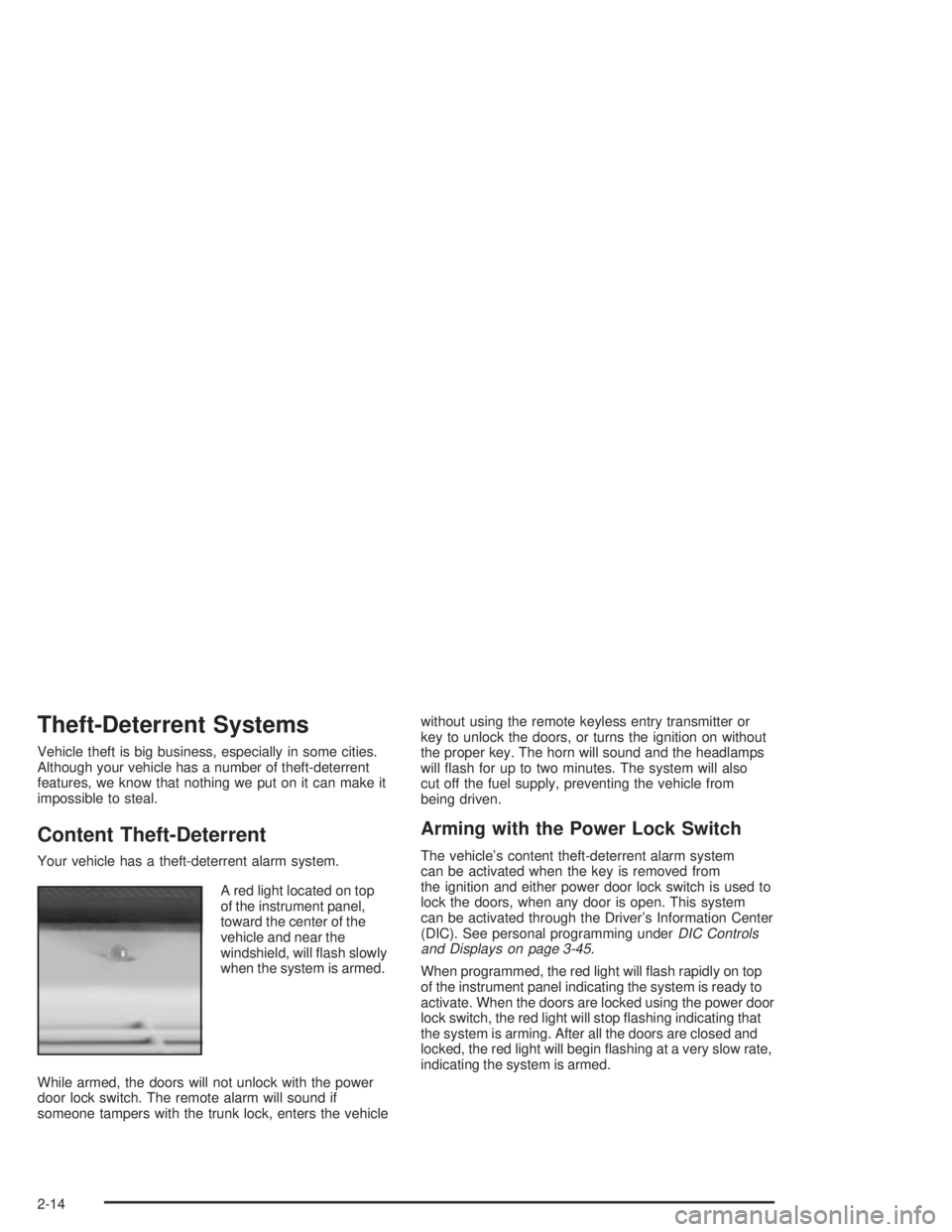
Theft-Deterrent Systems
Vehicle theft is big business, especially in some cities.
Although your vehicle has a number of theft-deterrent
features, we know that nothing we put on it can make it
impossible to steal.
Content Theft-Deterrent
Your vehicle has a theft-deterrent alarm system.
A red light located on top
of the instrument panel,
toward the center of the
vehicle and near the
windshield, will ¯ash slowly
when the system is armed.
While armed, the doors will not unlock with the power
door lock switch. The remote alarm will sound if
someone tampers with the trunk lock, enters the vehiclewithout using the remote keyless entry transmitter or
key to unlock the doors, or turns the ignition on without
the proper key. The horn will sound and the headlamps
will ¯ash for up to two minutes. The system will also
cut off the fuel supply, preventing the vehicle from
being driven.
Arming with the Power Lock Switch
The vehicle's content theft-deterrent alarm system
can be activated when the key is removed from
the ignition and either power door lock switch is used to
lock the doors, when any door is open. This system
can be activated through the Driver's Information Center
(DIC). See personal programming under
DIC Controls
and Displays on page 3-45.
When programmed, the red light will ¯ash rapidly on top
of the instrument panel indicating the system is ready to
activate. When the doors are locked using the power door
lock switch, the red light will stop ¯ashing indicating that
the system is arming. After all the doors are closed and
locked, the red light will begin ¯ashing at a very slow rate,
indicating the system is armed.
2-14
Page 79 of 432
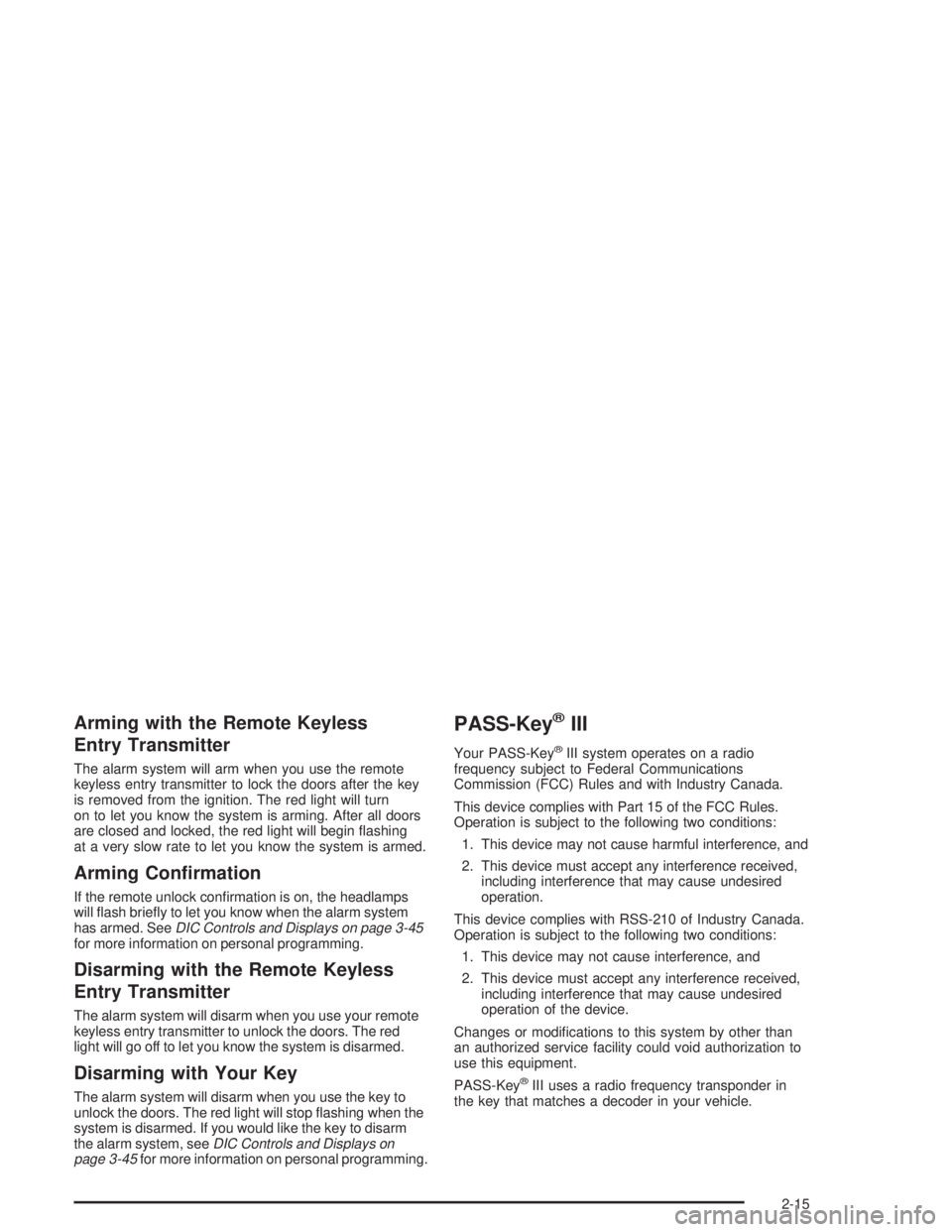
Arming with the Remote Keyless
Entry Transmitter
The alarm system will arm when you use the remote
keyless entry transmitter to lock the doors after the key
is removed from the ignition. The red light will turn
on to let you know the system is arming. After all doors
are closed and locked, the red light will begin ¯ashing
at a very slow rate to let you know the system is armed.
Arming Con®rmation
If the remote unlock con®rmation is on, the headlamps
will ¯ash brie¯y to let you know when the alarm system
has armed. See
DIC Controls and Displays on page 3-45for more information on personal programming.
Disarming with the Remote Keyless
Entry Transmitter
The alarm system will disarm when you use your remote
keyless entry transmitter to unlock the doors. The red
light will go off to let you know the system is disarmed.
Disarming with Your Key
The alarm system will disarm when you use the key to
unlock the doors. The red light will stop ¯ashing when the
system is disarmed. If you would like the key to disarm
the alarm system, see
DIC Controls and Displays on
page 3-45for more information on personal programming.
PASS-KeyžIII
Your PASS-KeyžIII system operates on a radio
frequency subject to Federal Communications
Commission (FCC) Rules and with Industry Canada.
This device complies with Part 15 of the FCC Rules.
Operation is subject to the following two conditions:
1. This device may not cause harmful interference, and
2. This device must accept any interference received,
including interference that may cause undesired
operation.
This device complies with RSS-210 of Industry Canada.
Operation is subject to the following two conditions:
1. This device may not cause interference, and
2. This device must accept any interference received,
including interference that may cause undesired
operation of the device.
Changes or modi®cations to this system by other than
an authorized service facility could void authorization to
use this equipment.
PASS-Key
žIII uses a radio frequency transponder in
the key that matches a decoder in your vehicle.
2-15
Page 80 of 432
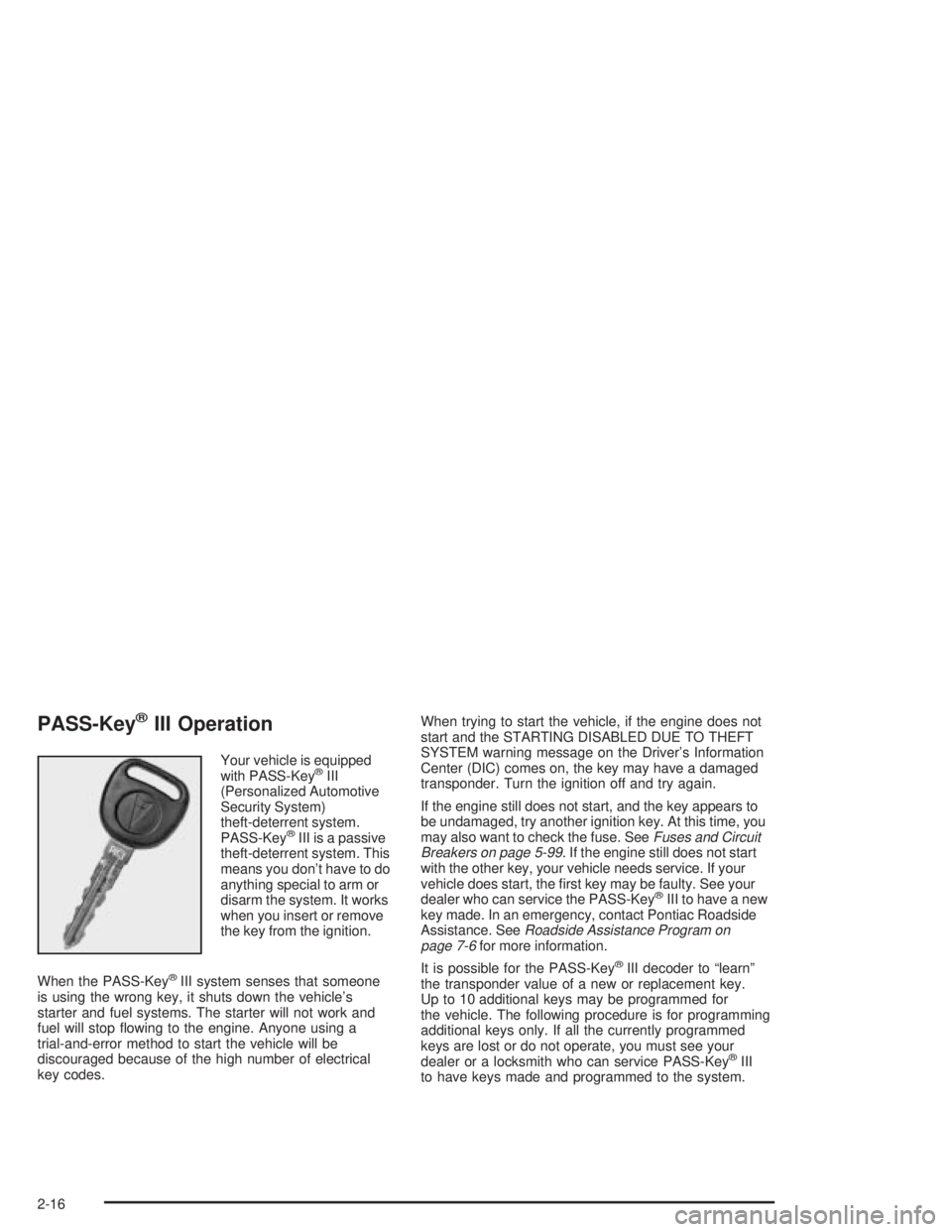
PASS-KeyžIII Operation
Your vehicle is equipped
with PASS-KeyžIII
(Personalized Automotive
Security System)
theft-deterrent system.
PASS-Key
žIII is a passive
theft-deterrent system. This
means you don't have to do
anything special to arm or
disarm the system. It works
when you insert or remove
the key from the ignition.
When the PASS-Key
žIII system senses that someone
is using the wrong key, it shuts down the vehicle's
starter and fuel systems. The starter will not work and
fuel will stop ¯owing to the engine. Anyone using a
trial-and-error method to start the vehicle will be
discouraged because of the high number of electrical
key codes.When trying to start the vehicle, if the engine does not
start and the STARTING DISABLED DUE TO THEFT
SYSTEM warning message on the Driver's Information
Center (DIC) comes on, the key may have a damaged
transponder. Turn the ignition off and try again.
If the engine still does not start, and the key appears to
be undamaged, try another ignition key. At this time, you
may also want to check the fuse. See
Fuses and Circuit
Breakers on page 5-99. If the engine still does not start
with the other key, your vehicle needs service. If your
vehicle does start, the ®rst key may be faulty. See your
dealer who can service the PASS-Key
žIII to have a new
key made. In an emergency, contact Pontiac Roadside
Assistance. See
Roadside Assistance Program on
page 7-6for more information.
It is possible for the PASS-Key
žIII decoder to ªlearnº
the transponder value of a new or replacement key.
Up to 10 additional keys may be programmed for
the vehicle. The following procedure is for programming
additional keys only. If all the currently programmed
keys are lost or do not operate, you must see your
dealer or a locksmith who can service PASS-Key
žIII
to have keys made and programmed to the system.
2-16
Page 81 of 432

Canadian Owners:If you lose or damage your keys,
only a GM dealer can service PASS-KeyžIII to
have new keys made. To program additional keys,
you will need two current driver's keys. You must add a
step to the following procedure. After Step 2, repeat
Steps 1 and 2 with the second current driver's key.
Then continue with Step 3.
To program the new key do the following:
1. Verify that the new key has PK3 stamped on it.
2. Insert the master key in the ignition and start
the engine. If the engine will not start, see your
dealer for service.
3. After the engine has started, turn the key to OFF,
and remove the key.
4. Insert the key to be programmed and turn it to RUN
within ®ve seconds of removing the original key.5. The SECURITY DISABLED DUE TO THEFT
SYSTEM warning message on the DIC will turn off,
once the key has been programmed. It may not
be apparent that the SECURITY DISABLED DUE
TO THEFT SYSTEM warning message went on due
to how quickly the key is programmed.
6. Repeat Steps 1 through 5 if additional keys are to
be programmed.
If you are ever driving and the SECURITY DISABLED
DUE TO THEFT SYSTEM warning message on the DIC
comes on and stays on, you will be able to restart
your engine if you turn it off. Your PASS-Key
žIII system,
however, is not working properly and must be serviced
by your dealer. Your vehicle is not protected by the
PASS-Key
žIII system at this time.
If you lose or damage your PASS-Key
žIII key, see your
dealer or a locksmith who can service PASS-KeyžIII
to have a new key made.
2-17
Page 82 of 432
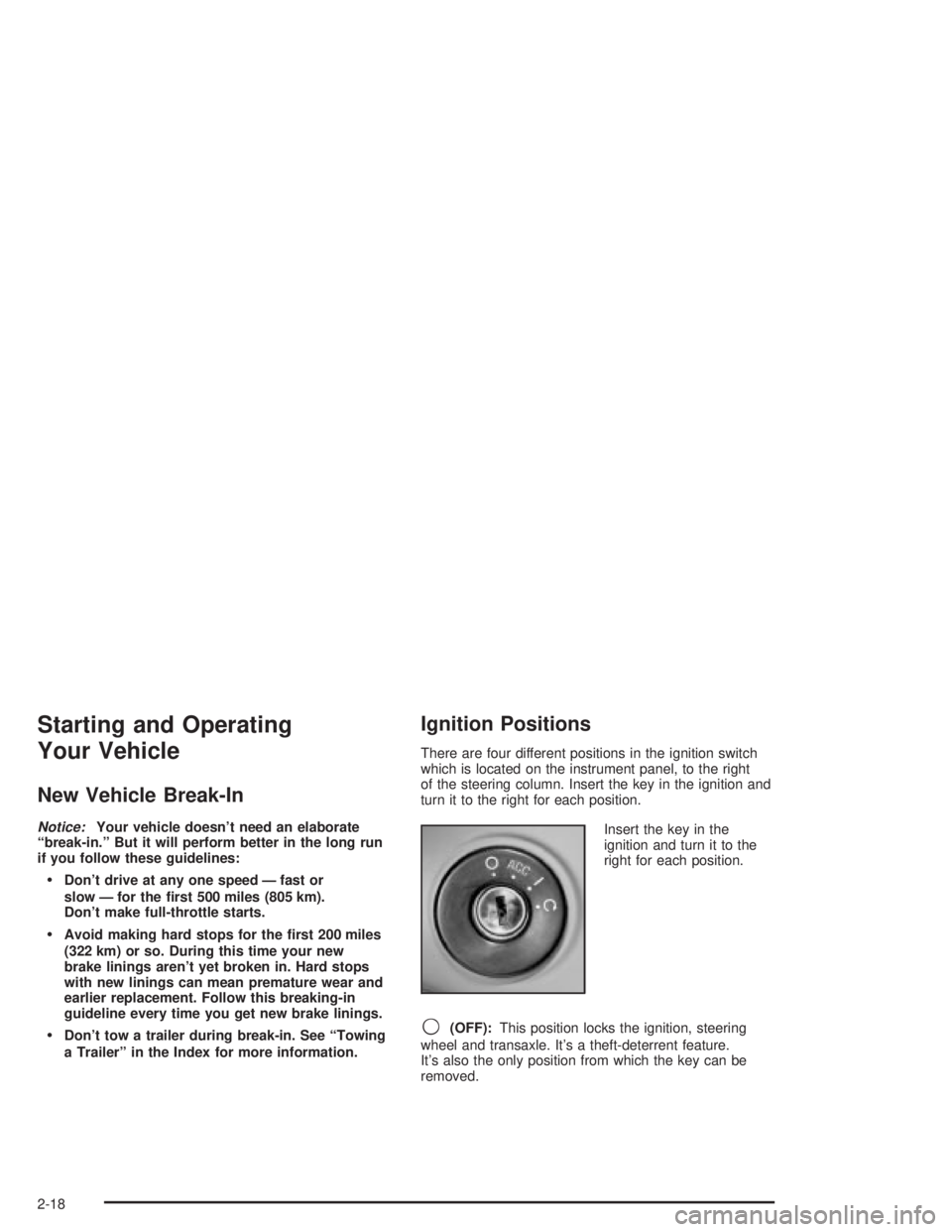
Starting and Operating
Your Vehicle
New Vehicle Break-In
Notice:Your vehicle doesn't need an elaborate
ªbreak-in.º But it will perform better in the long run
if you follow these guidelines:
·Don't drive at any one speed Ð fast or
slow Ð for the ®rst 500 miles (805 km).
Don't make full-throttle starts.
·Avoid making hard stops for the ®rst 200 miles
(322 km) or so. During this time your new
brake linings aren't yet broken in. Hard stops
with new linings can mean premature wear and
earlier replacement. Follow this breaking-in
guideline every time you get new brake linings.
·Don't tow a trailer during break-in. See ªTowing
a Trailerº in the Index for more information.
Ignition Positions
There are four different positions in the ignition switch
which is located on the instrument panel, to the right
of the steering column. Insert the key in the ignition and
turn it to the right for each position.
Insert the key in the
ignition and turn it to the
right for each position.
9(OFF):This position locks the ignition, steering
wheel and transaxle. It's a theft-deterrent feature.
It's also the only position from which the key can be
removed.
2-18
Page 83 of 432
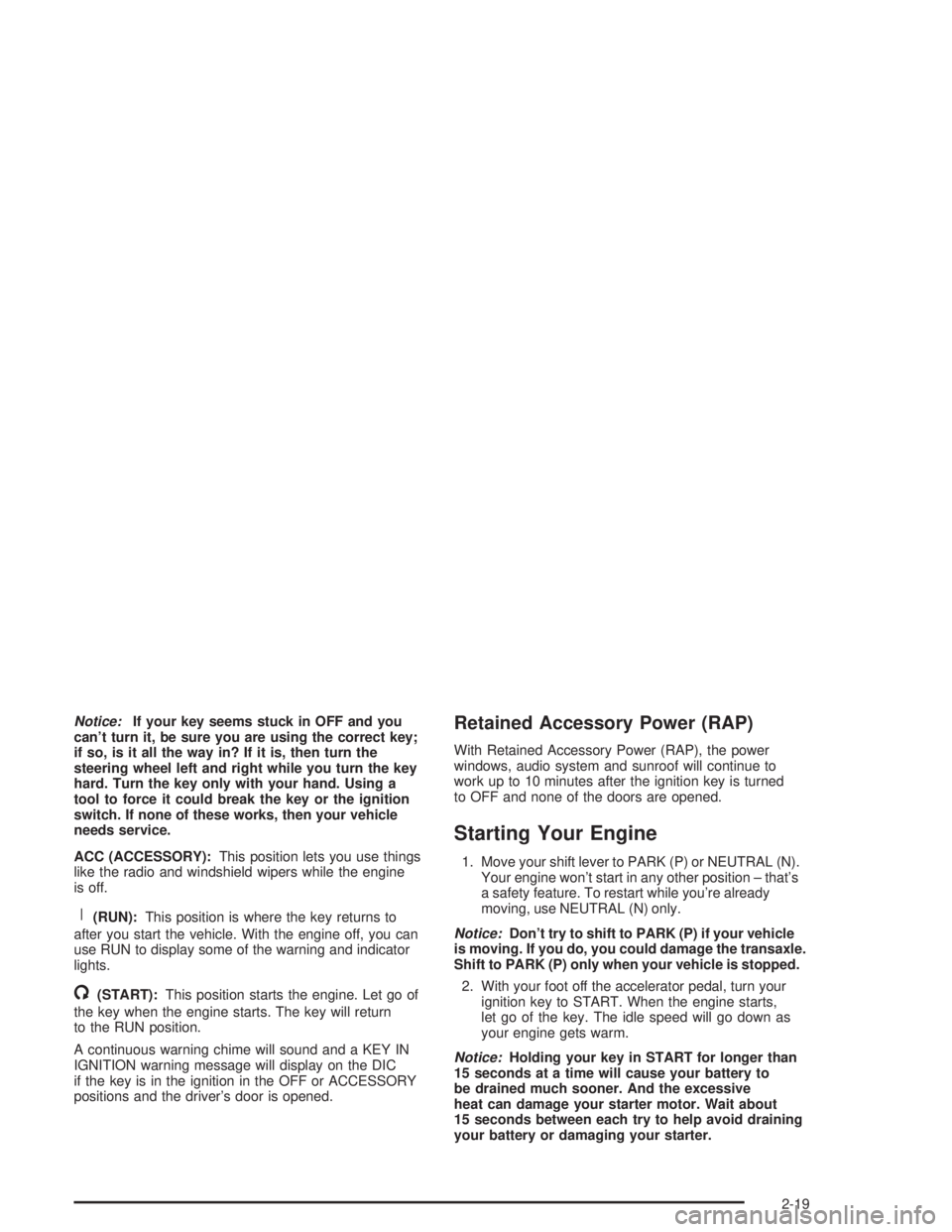
Notice:If your key seems stuck in OFF and you
can't turn it, be sure you are using the correct key;
if so, is it all the way in? If it is, then turn the
steering wheel left and right while you turn the key
hard. Turn the key only with your hand. Using a
tool to force it could break the key or the ignition
switch. If none of these works, then your vehicle
needs service.
ACC (ACCESSORY):This position lets you use things
like the radio and windshield wipers while the engine
is off.
R(RUN):This position is where the key returns to
after you start the vehicle. With the engine off, you can
use RUN to display some of the warning and indicator
lights.
/(START):This position starts the engine. Let go of
the key when the engine starts. The key will return
to the RUN position.
A continuous warning chime will sound and a KEY IN
IGNITION warning message will display on the DIC
if the key is in the ignition in the OFF or ACCESSORY
positions and the driver's door is opened.
Retained Accessory Power (RAP)
With Retained Accessory Power (RAP), the power
windows, audio system and sunroof will continue to
work up to 10 minutes after the ignition key is turned
to OFF and none of the doors are opened.
Starting Your Engine
1. Move your shift lever to PARK (P) or NEUTRAL (N).
Your engine won't start in any other position ± that's
a safety feature. To restart while you're already
moving, use NEUTRAL (N) only.
Notice:Don't try to shift to PARK (P) if your vehicle
is moving. If you do, you could damage the transaxle.
Shift to PARK (P) only when your vehicle is stopped.
2. With your foot off the accelerator pedal, turn your
ignition key to START. When the engine starts,
let go of the key. The idle speed will go down as
your engine gets warm.
Notice:Holding your key in START for longer than
15 seconds at a time will cause your battery to
be drained much sooner. And the excessive
heat can damage your starter motor. Wait about
15 seconds between each try to help avoid draining
your battery or damaging your starter.
2-19
Page 84 of 432
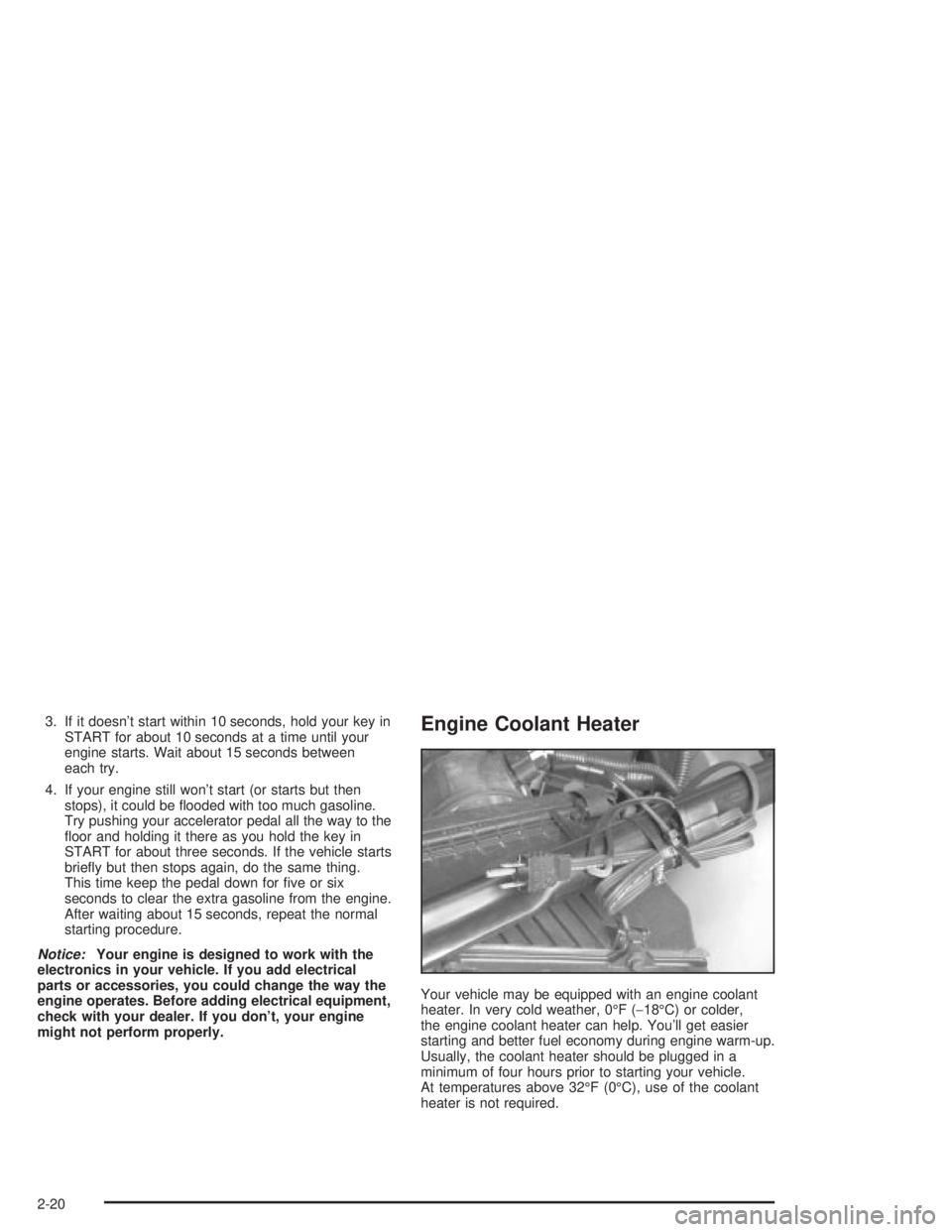
3. If it doesn't start within 10 seconds, hold your key in
START for about 10 seconds at a time until your
engine starts. Wait about 15 seconds between
each try.
4. If your engine still won't start (or starts but then
stops), it could be ¯ooded with too much gasoline.
Try pushing your accelerator pedal all the way to the
¯oor and holding it there as you hold the key in
START for about three seconds. If the vehicle starts
brie¯y but then stops again, do the same thing.
This time keep the pedal down for ®ve or six
seconds to clear the extra gasoline from the engine.
After waiting about 15 seconds, repeat the normal
starting procedure.
Notice:Your engine is designed to work with the
electronics in your vehicle. If you add electrical
parts or accessories, you could change the way the
engine operates. Before adding electrical equipment,
check with your dealer. If you don't, your engine
might not perform properly.
Engine Coolant Heater
Your vehicle may be equipped with an engine coolant
heater. In very cold weather, 0ÉF (-18ÉC) or colder,
the engine coolant heater can help. You'll get easier
starting and better fuel economy during engine warm-up.
Usually, the coolant heater should be plugged in a
minimum of four hours prior to starting your vehicle.
At temperatures above 32ÉF (0ÉC), use of the coolant
heater is not required.
2-20